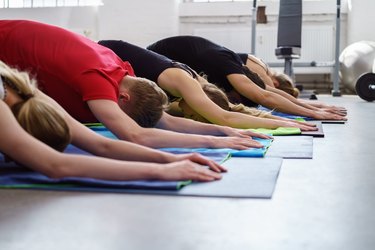
Standing with an increased curve, or lordosis, in your low back may seem like a great way to accentuate your derriere; however, it can actually have significant consequences.
While a some curvature in your lumbar spine is normal, an imbalance in the muscles of your core and hips can lead to excessive amounts of lordosis and can result in the development of low back pain. Take several easy steps to help improve the curve in your lower back.
Video of the Day
Video of the Day
Improve Your Hip Flexibility
When your pelvis is tilted forward, it causes your iliopsoas muscles to tighten. Tightness in these muscles, which sit near your groin and help to flex your hips, contributes to increased curvature in your lower back. Improving the flexibility in these muscles makes it easier to achieve a proper low back position.
To stretch the iliopsoas: Get into a kneeling lunge position with your right foot positioned in front of your body. Keeping your trunk erect and your left knee in contact with the ground, shift your body forward until you feel a stretch in the front of your left hip. After holding this stretch for 30 seconds, return to the starting position. Complete three to five repetitions before alternating the position of your legs and repeating the exercise on the right hip.
Strengthen Your Abdominals
The muscles in your stomach play many important roles. Not only do they contribute to spinal stability, but these muscles also tilt the pelvis backward, or posteriorly. This helps to decrease excessive curvature in the lumbar spine and to decrease the strain on the muscles of the low back. There are many effective exercises for strengthening your abdominals and other core muscles.
Do the plank: Place both forearms on the ground and lift your body up onto your toes. Engage your abdominals and hold your spine straight as you maintain this position. After 10 seconds, take a break before repeating the exercise 10 times. Make sure to keep breathing steadily as you hold your planks.
Do braced marching: Lie on your back with your knees bent and your feet on the floor. Then, tilt your pelvis backwards as you flatten your low back against the ground. Hold this tilt and slowly alternate marching each leg up and back down again. After completing 10 repetitions with each leg, take a rest. If able, do two to three sets of this exercise.
Stretch Your Back
When your pelvis tips forward and your low back becomes more curved, the muscles that line your lumbar spine become shortened and tight. By stretching these muscles, called the erector spinae, you can increase the mobility in your pelvis and return to a normal amount of curvature in your low back.
To stretch the erector spinae: Kneel on the ground and sit your buttocks back onto your heels. Then, place your palms flat on the ground in front of you and slide them forward until you feel a pull in your lower back. Do not allow your buttocks to lift from your heels. Do this stretch three to five times making sure to hold each stretch about 30 seconds.
Target Your Gluteus Maximus
Along with the abdominal muscles, the gluteus maximus is one of the primary muscles that tilts the pelvis posteriorly. Strengthening this muscle helps you avoid resting in a pelvic position that increases the lordosis in your low back. One of the most effective exercises to strengthen this region is the bird dog.
Do the bird dog: To perform this exercise, get onto your hands and knees and flatten your low back by engaging your abdominal muscles. Then, lift and straighten one arm in front of you and the opposite leg behind you without allowing your pelvis to tilt. Hold this position for 10 seconds before lowering your extremities back to the ground and repeating with the alternate arm and leg. Complete 10 repetitions on each side before taking a break.
Read more: Swayback Posture Exercises
Proceed with Caution
While increased lumbar curvature may be caused by a combination of muscle weakness and tightness, it may also be from something far more serious. It's very important to report low back symptoms to a doctor immediately if they are accompanied by sharp pain, numbness or tingling, weakness in the lower body or incontinence of the bowel or bladder.